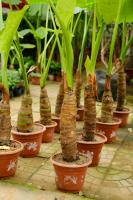Where and When to Plant a Cherry Tree
Cherry trees are beautiful and productive additions to any garden or landscape. They are also relatively easy to grow, as long as you follow some basic guidelines regarding where and when to plant them.
Choosing a Location
The first step in planting a cherry tree is to choose a suitable location. Cherry trees prefer areas with full sun exposure, where they can get at least six hours of direct sunlight per day. They also need well-drained soil that is rich in organic matter, such as compost or aged manure. Avoid planting cherry trees in areas with heavy clay or compacted soil, which can restrict root growth and cause waterlogging.
It is also important to consider the size of the tree at maturity when choosing a planting spot. Cherry trees can grow up to 25 feet tall and wide, so make sure to select an area with enough space to accommodate their size. They should be planted at least 15 to 20 feet away from buildings, fences, or other trees to allow enough room for air circulation and proper sun exposure.
When to Plant a Cherry Tree
The best time to plant cherry trees is during the dormant season, which typically falls between late fall and early spring. This is when the tree is not actively growing and can devote its energy to root development. Planting during the dormant season also reduces the risk of transplant shock and allows the tree to establish itself before the growing season begins.
If you live in a cold climate, it is best to plant cherry trees in early spring, after the danger of frost has passed. This will allow the tree to establish itself before the summer heat sets in. In warmer climates, it is possible to plant cherry trees in the fall or winter, as long as the ground is not frozen.
Planting Techniques
When planting a cherry tree, it is important to dig a hole that is at least twice as wide and deep as the root ball. The hole should be filled with nutrient-rich soil, such as a mix of topsoil and compost or aged manure. The tree should be set in the hole so that the graft union (where the tree was budded or grafted onto the rootstock) is about two inches above the ground.
After planting, the tree should be watered thoroughly to settle the soil and eliminate any air pockets around the roots. It is important to keep the soil consistently moist but not waterlogged, especially during the first few years of growth. Mulching around the base of the tree with a layer of organic material, such as straw or wood chips, can help retain moisture and suppress weeds.
Caring for Your Cherry Tree
Once your cherry tree is established, it will require minimal care. Water it regularly during dry spells, especially during the summer months. Prune the tree in late winter or early spring, removing any dead or damaged branches and thinning out any crowded or crossing branches. Fertilize the tree with a balanced, slow-release fertilizer in early spring, and again in late spring or early summer.
Harvest your cherries when they are ripe, which typically occurs in late spring or early summer, depending on the variety. Cherries can be eaten fresh, cooked, or preserved, and they are a delicious and nutritious addition to any diet.
Conclusion
Planting a cherry tree can be a rewarding experience that adds beauty and function to your garden or landscape. By choosing a suitable location, planting at the right time, and following proper planting and care techniques, you can enjoy a bountiful harvest of healthy and delicious cherries for years to come.

 how many times do yo...
how many times do yo... how many planted tre...
how many planted tre... how many pine trees ...
how many pine trees ... how many pecan trees...
how many pecan trees... how many plants comp...
how many plants comp... how many plants can ...
how many plants can ... how many plants and ...
how many plants and ... how many pepper plan...
how many pepper plan...




























